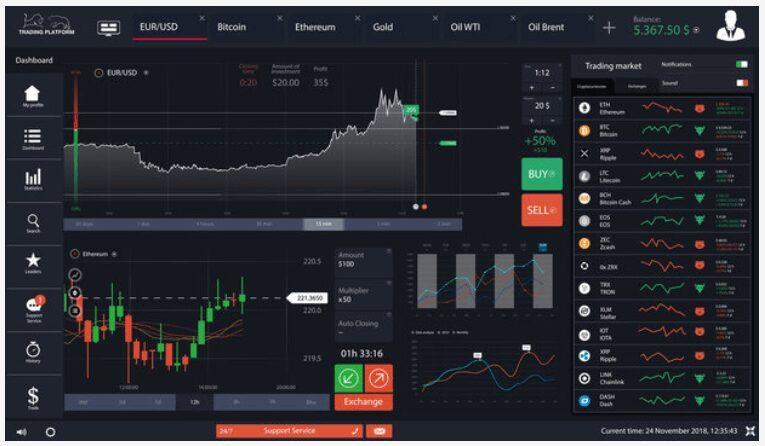In an age where technology shapes every facet of our lives, the digital market has emerged as a groundbreaking frontier for both investors and entrepreneurs. Navigating this vibrant landscape of trading platforms can be daunting, yet it offers unprecedented opportunities for those willing to explore. From cryptocurrencies to stocks and commodities, the digital marketplace is a dynamic environment that thrives on innovation and accessibility. This guide aims to illuminate the pathways available within this digital realm, providing insights that will help traders-from novices to seasoned professionals-make informed decisions and harness the full potential of their trading endeavors. As we embark on this journey, we will delve into the various platforms that define today’s trading experience, unpack their functionalities, and highlight the essential strategies needed to thrive in this ever-evolving ecosystem. Join us as we explore the tools and techniques that can elevate your trading skills and ensure you navigate the digital market with confidence.
Understanding Different Types of Trading Platforms
In the expansive world of financial markets, trading platforms serve as the crucial interface between traders and the securities they wish to buy or sell. Understanding the different types of trading platforms available can enhance your trading experience and equip you with the tools needed to make informed decisions. Broadly, these platforms can be categorized into three main types:
- Web-Based Platforms: Accessible through any browser, these platforms are convenient for traders who prefer flexibility. They typically require no downloads and are ideal for on-the-go trading.
- Desktop Platforms: These software applications offer robust features and are often favored by serious traders who require advanced charting and analysis tools. Installation is needed, but they usually provide greater performance and customizability.
- Mobile Platforms: Designed specifically for smartphones and tablets, mobile platforms allow traders to monitor and execute trades on the go. While they may not offer the full range of features found on desktop platforms, they provide essential functionalities for quick trades.
When selecting a trading platform, it’s essential to consider factors such as ease of use, available tools, and fees. Many platforms also provide unique features tailored to different trading styles, such as:
- Social Trading Features: Allowing you to mimic the trades of successful investors.
- Automated Trading Options: Facilitating trades based on preset algorithms and strategies.
- Comprehensive Educational Resources: Helping beginners gain a deeper understanding of trading fundamentals.

Evaluating Key Features for Success in Digital Trading
When exploring the digital trading landscape, certain features stand out as essential for achieving success. User-friendly interfaces and intuitive navigation are crucial, as they streamline the trading process and reduce the learning curve for new traders. Additionally, robust security measures such as two-factor authentication and encryption help protect sensitive financial data from cyber threats, inspiring trust and confidence among users. Other significant features include access to real-time market data, which enables traders to make informed decisions promptly, and advanced charting tools that analyze trends and patterns effectively.
Moreover, integrating a variety of order types-such as market orders, limit orders, and stop-loss orders-can enhance trading strategies for both novice and experienced traders. Platforms that provide educational resources such as tutorials, webinars, and market analysis enable users to continuously improve their skills and understanding of market dynamics. Finally, accessible customer support, available through multiple channels like live chat, email, or phone, plays a vital role in resolving issues swiftly and ensuring a smooth trading experience.
Navigating Security and Risk Management in Online Markets
In the world of online trading, understanding the intricate landscape of security and risk management is paramount. With the rise of digital marketplaces, traders are increasingly susceptible to cyber threats that can jeopardize both their personal information and financial assets. To safeguard against these risks, consider implementing strong data protection measures such as:
- Encryption to secure sensitive data
- Data Loss Prevention (DLP) tools to monitor and prevent unauthorized data access
- Regular security audits to identify potential vulnerabilities
Your ability to navigate potential risks also depends on continuous education and awareness of emerging threats. As cyber-attacks evolve, so should your strategies. It’s essential to establish a robust incident response plan that includes:
- Regular training for all team members on identifying phishing attempts and other malicious activities
- Collaboration with cybersecurity experts to stay abreast of the latest threats and compliance requirements
- Investment in advanced security technologies to mitigate risk effectively
Choosing the Right Platform: Tips and Recommendations for Traders
When selecting a trading platform, it’s crucial to consider factors that align with your trading style and objectives. Different platforms offer various features, such as user-friendly interfaces, advanced analytical tools, or educational resources to help beginners gain confidence. Key features to evaluate include:
- Cost Structure: Look for platforms with low or no commissions, and be aware of any hidden fees that can eat into your profits.
- Asset Variety: Ensure the platform offers a diverse selection of assets, such as stocks, ETFs, and cryptocurrencies, to diversify your portfolio.
- Tools and Resources: Explore platforms that provide educational materials, demo accounts, and analytical tools to aid in decision-making.
Additionally, consider the reliability and security of the platform. You want to trade on a regulated exchange that ensures your investments are safe. Also, think about:
- Customer Support: Reliable support can be invaluable, especially when you encounter issues or have questions.
- Mobile Compatibility: If you prefer trading on the go, check for a strong mobile application that maintains functionality.
- User Reviews: Research user feedback and reviews to gain insights into real-world experiences with the platform.
In Retrospect
As you embark on your journey through the digital market, remember that the landscape of trading platforms is ever-evolving. The key to success lies not just in understanding the tools at your disposal but also in staying informed and adapting to changes in technology and user needs. Equip yourself with the insights gathered from this guide, exploring the features, benefits, and challenges of various platforms. Whether you’re a seasoned trader or a newcomer, navigating this digital terrain requires patience, precision, and continual learning. Embrace the opportunities that digital trading platforms present, and let your exploration of the market be both profitable and enriching. Happy trading!












